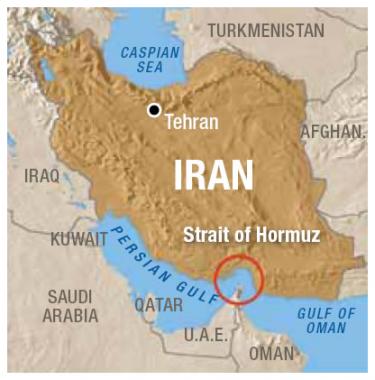

Information Related to "Closing the Strait of Hormuz: A Serious Iranian Threat"
 | Audio/Video |
Tehran has coveted complete control over the narrow Strait of Hormuz -- only 24 miles wide at its narrowest point -- for many years. How important is this crucial Middle Eastern waterway?

About 20 percent of the world's oil exports-and more than a third of all oil shipped by sea-passes through this narrow chokepoint bordered by Iran and Oman. Estimates for 2025 run as high as 60 percent.
Disrupting or closing this vital waterway would most likely put a stranglehold on the world economy, leading to skyrocketing gasoline prices and a probable worldwide economic downturn if not outright recession. And Iran need not completely blockade the strait militarily-attacks on a few tankers with anti-ship missiles, submarines or small attack boats could accomplish the same end by making shipping oil prohibitively expensive due to sky-high insurance costs.
Western nations understandably keep a close eye on this strait. Several years ago Commentary magazine ran an article that stated, "The Tehran regime has made no secret of its desire to gain control of the Straits as a part of its larger strategy of turning the Gulf into an Iranian lake" (Arthur Herman, "Getting Serious About Iran: A Military Option," November 2006). A senior Iranian government official had issued a warning to the European Union. "We have the power to halt oil supply," he said, "down to the last drop" (quoted by Herman).
If this actually happened, blackmail of other nations would most likely be the order of the day, and Iran isn't afraid to use this threat. It's no secret that the United Nations is largely impotent when it comes to passing effective sanctions directed at changing Iranian behavior-not least in part because China, needing Iranian oil to fuel its economy, and Russia, an ally of Iran, are two of five UN Security Council members wielding veto power over such actions.
And the Strait of Hormuz isn't the only area in which Iran maintains a stranglehold over a large part of the global energy supply. American journalist Robert Kaplan wrote in Foreign Policy magazine: "Virtually all of the greater Middle East's oil and natural gas lies in this region [the Persian core, stretching from the Caspian Sea in the north to the Persian Gulf on Iran's south]. Just as shipping lanes radiate from the Persian Gulf, pipelines are increasingly radiating from the Caspian region to the Mediterranean, the Black Sea, China, and the Indian Ocean" ("The Revenge of Geography," May-June 2009, p. 105).
Continuing in the samearticle: "The only country that straddles both energy producing-areas is Iran . . . The Persian Gulf possesses 55 percent of the world's crude-oil reserves, and Iran dominates the whole gulf . . . a coastline of 1,317 nautical miles, thanks to its many bays, inlets, coves, and islands that offer plenty of excellent places for hiding tanker-ramming speedboats."
Iranian influence over such valuable natural resources remains a persistent worry to the West and the world. The stakes run very high in the highly volatile Middle East!
©1995-2022 United Church of God, an International AssociationRelated Information:
Table of Contents that includes "Closing the Strait of Hormuz: A Serious Iranian Threat"
Other Articles by Scott Ashley
Origin of article "Closing the Strait of Hormuz: A Serious Iranian Threat"
Keywords: Iran Hormuz oil supply Persian Gulf
Iran: